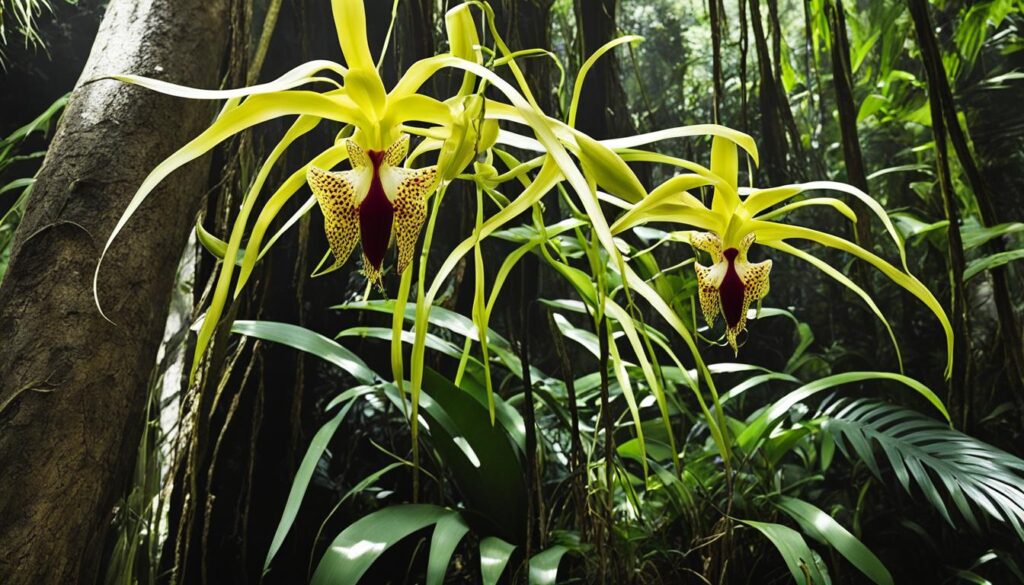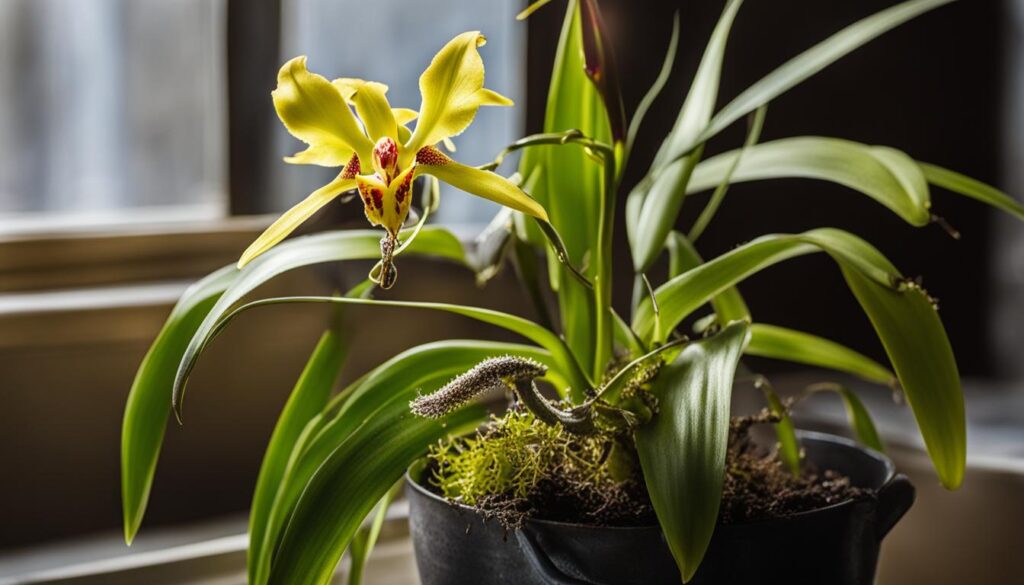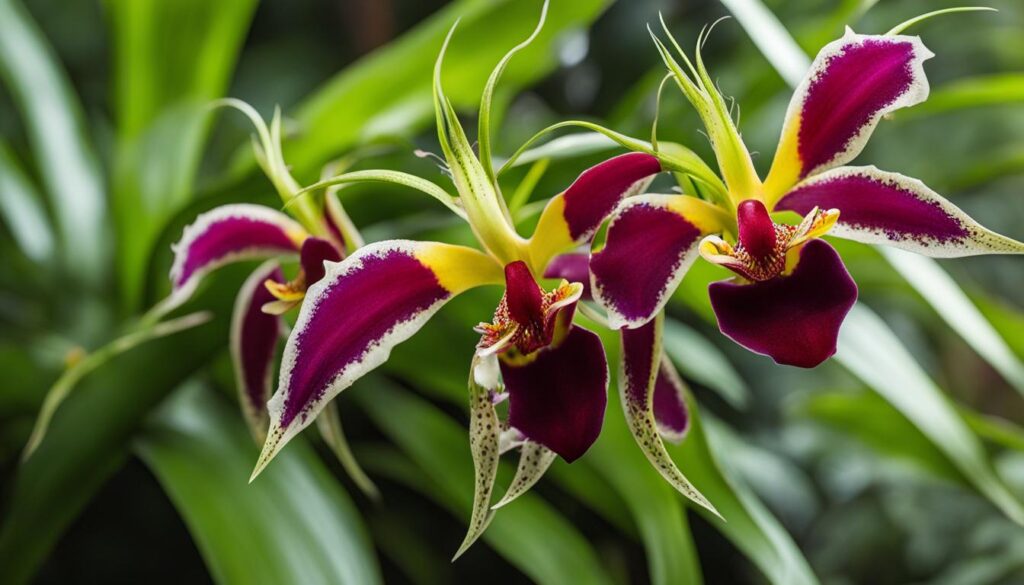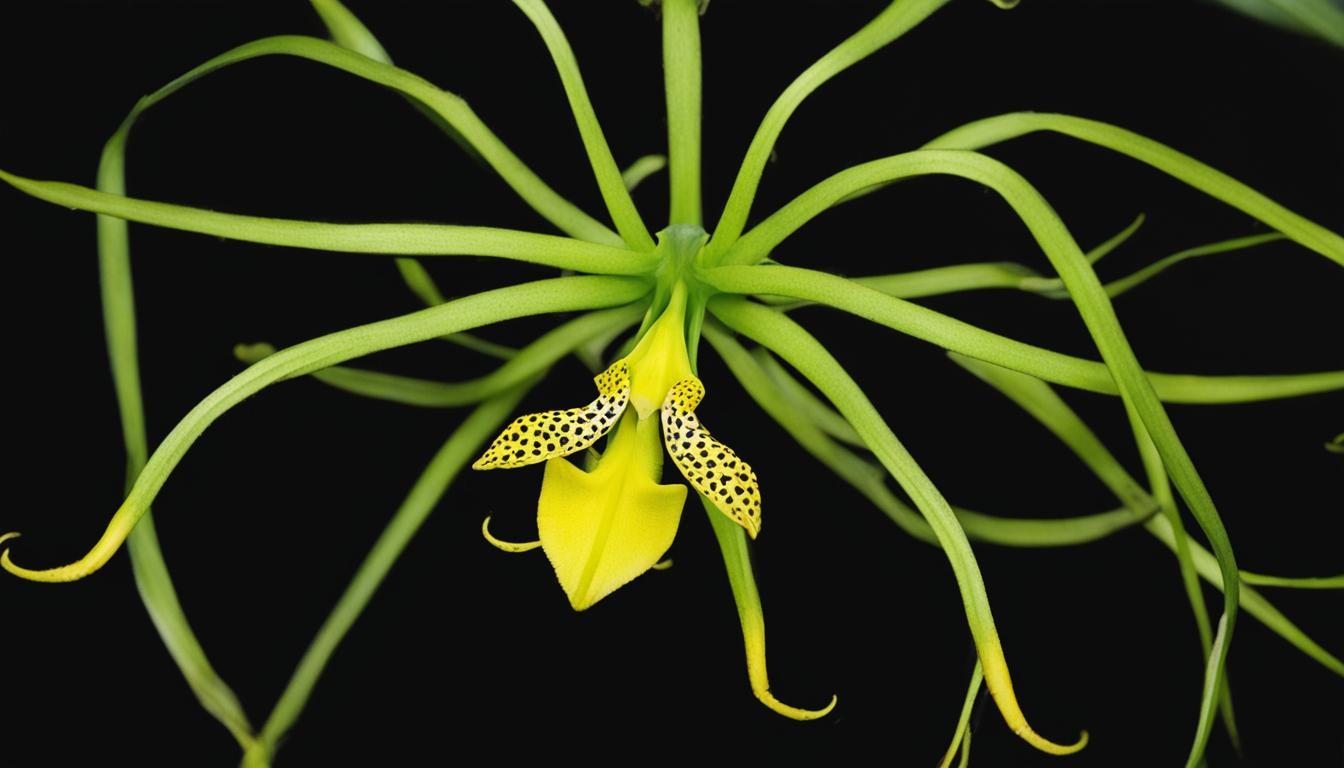Quick Facts
| Characteristic | Detail |
|---|---|
| Countries of Origin | Central and South America, particularly in Colombia, Ecuador, and Peru. |
| Colors | Mainly yellow and green, often with brown or maroon markings. |
| Size | Can grow up to 2 feet tall, with flower spikes that can extend several feet in length. |
| Difficulty To Grow | Moderate. Requires specific care but can be grown successfully with the right conditions. |
| Bloom Season | Late spring to fall, depending on the species and growing conditions. |
| Light Requirements | Bright, indirect light. Can tolerate some direct morning sun but should be protected from strong afternoon sunlight. |
| Watering Needs | Keep evenly moist during active growth; reduce watering in winter. |
| Temperature Range | Prefer warm days (70-85°F or 21-29°C) and cooler nights (55-65°F or 13-18°C). |
| Potting Medium | Well-draining orchid mix, often with bark, perlite, and charcoal components. |
| Propagation Methods | Division or from keikis (baby plants that form on the flower spike of some species). |
| Common Pests and Diseases | Spider mites, scale insects, and root rot if over-watered. |
| Fragrance | Some species are fragrant, often described as sweet or spicy. |
| Lifespan/Longevity | With proper care, can live and bloom for many years. |
| Conservation Status | Not widely considered endangered, but some species may be threatened by habitat loss. |
| Unique Features | Known for their spider-like flowers, with long, slender sepals and petals. |
As an avid gardener and horticulturist, I’ve always been drawn to the unique and exotic, and nothing captures this essence quite like Brassia Orchids, commonly referred to as spider orchids.
These stunning specimens exude an allure that stems from their striking resemblance to arachnids, dangling gracefully from trees in their native habitats.
The beauty of Brassia Orchids lies not only in their appearance but also in the care put into nurturing them. Learning to nurture Brassia Orchids is both a delicate art and a fulfilling journey, allowing one to observe up close the artistry of nature embodied in these stunning spider orchids.
Key Takeaways
- Brassia Orchids are known for their unique, spider-like blooms.
- Native to North America and tropical regions, their care reflects their exotic origins.
- Their alluring beauty is a highlight for any orchid enthusiast looking to expand their collection.
- Understanding the specific needs of spider orchids is key to successful cultivation.
- Nurturing these orchids can be a rewarding experience with stunning visual rewards.
Unveiling the Mystique of Spider Orchids
As a passionate orchid enthusiast, I’ve been mesmerized by the enigmatic beauty of Brassia orchids. Commonly known as spider orchids, these bewitching plants embody a combination of elegance and mystery, drawing orchid lovers into their intricate world.
From the long, slender pseudobulbs to their remarkable flower structures, each facet of Brassia orchid care is a step towards uncovering their secrets.
The Intriguing Appearance of Brassia Orchids
Among the myriad of Brassia orchid varieties, each presents a captivating display that defies conventional floral patterns. The signature characteristic of the Brassia orchid is its elongated petals and sepals, which splay outwards, mimicking the legs of a spider.
This unique adaptation not only serves a functional role in the plant’s lifecycle but also adds to the alluring diversity within the orchid family, making Brassia orchid care tips integral for maintaining their stunning appearance.
Brassia Orchids’ Mimicry and Pollination Strategies
The wondrous spider orchid mimicry extends beyond its physical allure, playing a crucial role in spider orchid pollination. The plant’s semblance to arachnids is no mere coincidence; it is a fascinating example of evolutionary adaptation for attracting specific pollinators.
Predatory wasps, deceived by the orchid’s spider-like flowers, engage with the plant as they would with prey, unwittingly becoming agents in the pollination process.
This symbiotic relationship exemplifies the ingenuity of nature’s designs, underscoring the importance of respecting and replicating natural conditions in Brassia orchid care.
In the table below, I’ve detailed some intriguing aspects of Brassia orchid varieties and their unique pollination strategies:
| Brassia Orchid Variety | Notable Mimicry Feature | Pollinator Attracted |
|---|---|---|
| Brassia verrucosa | Long, wart-like calluses on sepals | Spider-hunting wasps |
| Brassia arcuigera | Arching radial sepals | Pollinating bees |
| Brassia caudata | Exaggerated ‘spidery’ tendrils | Wasp species seeking prey |
Understanding how different Brassia orchids engage with their pollinators gives me a deeper appreciation for the species. With each orchid care session, I feel like a custodian of nature’s exquisite canvas, nurturing both the beauty and ecological wonders of these incredible plants.
A Brief History and Habitat of Brassia Orchids

As an enthusiast dedicated to the cultivation and preservation of these rare beauties, I’ve been enchanted by the intricate story and residence of the Brassia orchid. Known for their striking spider-like appearance, these plants possess a history as captivating as their unique form.
Their journey begins in the lush regions across southeastern North America, the West Indies, and Central and South America, where they’ve flourished in the wild for centuries.
Native Regions and Natural Environments
Often found in the boughs of tall trees, these artistic creations have chosen the epiphytic path of life, cleverly securing themselves above the ground.
The native habitat of Brassia Orchids is one where dappled sunlight filters through the canopy, and humidity caresses their elongated petals.
This elevated existence exposes them to the ample air circulation they crave and provides the perfect vantage point for their pollinators. When I immerse myself in their world, offering them the essence of their native habitat through my Brassia orchid growing guide, I replicate these pristine conditions in my own greenhouse.
Conservation Status of Wild Brassia Orchids
Yet, despite their robust adaptability within the wild, the Brassia species faces threats that could unravel the fabric of their existence. Humanity’s imprint—habitat destruction and the sometimes insatiable demand from collectors—casts a shadow over their survival.
This has propelled me into action, as adhering to the wild Brassia orchid conservation protocols is not just a passion but a responsibility. By promoting and implementing responsible Brassia orchid care instructions, we are the custodians of these living legacies.
It ensures that these fascinating species, with their leggy blossoms reaching for the skies, continue to dance in the wild for generations to come.
| Region | Primary Threats | Conservation Status |
|---|---|---|
| Southeastern North America | Habitat Loss, Urban Development | Vulnerable |
| West Indies | Illegal Collection, Deforestation | Endangered |
| Central and South America | Agricultural Expansion, Climate Change | Risk of Extinction |
The Art of Cultivating Brassia Orchids
As an enthusiast ready to embark on the journey of cultivating Brassia Orchids, understanding the fundamental requirements is paramount. Throughout my experience, I’ve come to cherish the delicate balance that these exquisite plants demand.
Brassia orchid care for beginners might initially seem daunting; however, adopting the right practices can make Brassia orchid indoor care an incredibly rewarding pastime. Let me guide you through the essential elements of cultivating Brassia Orchids successfully.

- Temperature: Brassia Orchids flourish in moderate temperatures. Aim to provide an environment with daytime temperatures of 65-75°F (18-24°C) and slightly cooler nights.
- Lighting: These orchids prefer bright, indirect sunlight. North or East-facing windows are ideal locations to supply the necessary light without the risk of scorching their delicate leaves.
- Humidity: Recreate the humidity of their natural habitat by maintaining humidity levels at 40-70%. This can be achieved with the use of a humidifier or by placing a water-filled tray with pebbles beneath the pot, ensuring that the base does not sit in water.
- Watering: Regular but sparing, the watering routine for Brassia Orchids should simulate tropical rain patterns—thoroughly wetting the roots while allowing for complete drying before the next watering.
- Feeding: Feed your Brassia Orchids with a balanced orchid fertilizer every other week during active growth to support their splendid blooms.
Remember, the journey of raising Brassia Orchids at home is as much about attentiveness as it is about artistic expression. My personal experience with these plants has taught me the importance of patience and precision in crafting the optimal environment for their prosperity.
By focusing on these fundamental care requirements, you will witness the vibrant dance of Brassia Orchid blooms gracing your indoor garden.
Brassia Orchid Varieties and Their Unique Traits
Within the mesmerizing world of orchids, Brassia orchid varieties hold a unique position. Renowned for their spider-like blooms, these orchids offer extensive diversity to cultivators and collectors.
Each variant within the Brassia family showcases distinct features from captivating color palettes to intricate markings that accentuate their exotic beauty. Let’s delve into the most sought-after species and the groundbreaking hybrids that redefine the genus.
Common Species and Their Distinguishing Features
Spider orchid species, such as the Brassia antherotes and Brassia arcuigera, are praised for their distinct floral architecture and resemblance to arachnids, which is a marvel of mimicry in the natural world.
The inherent charm of these species lies in their long, slender sepals and petals, providing a visual feast that’s both eerie and enchanting. Here’s a glimpse of their distinguishing features:
- Brassia antherotes: This variety is noted for its light green flowers adorned with maroon spots, casting a bi-color effect that’s irresistible to orchid lovers.
- Brassia arcuigera: With its larger flowers often spanning up to 12 inches, and a distinctive scent, this species makes for an arresting display.
- Brassia verrucosa: Another popular variant, known for its waxy, fragrant blooms showcasing a pattern of little warts (verrucae) that adds texture and depth to its appearance.
The Hybrid Revolution: Bratonia (Brassia x Miltonia) Spider Orchids
As aficionados yearn for novel and stunning varieties, the hybridization between Brassia and Miltonia orchids has led to the creation of remarkable Bratonia orchids.
These hybrids, commonly known as “Miltassia,” combine the strength and resilience of Miltonia with the distinctive spider-like form of Brassia, creating a spectacular botanical fusion.
For example, Bratonia Shelob ‘Tolkien’ exemplifies the epitome of this hybridization effort, sporting large star-shaped flowers with bold, contrasting colors that can captivate anyone’s gaze.
The intergeneric crosses are not only aesthetically appealing but also more adaptable to a variety of growing conditions, making them an excellent choice for intermediate orchid growers.
A fascinating aspect of caring for Bratonia orchids is witnessing the seamless blend of features from both parent genera. Colors may range from subtle pastels to vivid hues, and the diverse markings inherent in these hybrids often result in a breathtaking spectacle when in bloom.
Whether you’re a seasoned grower or a newcomer enamored by the charm of orchids, exploring the Brassia varieties and their hybrids such as Bratonia offers an endless journey of discovery.
It is the distinct allure of each species and intergeneric hybrid that contributes to the ever-expanding popularity of these ornamental wonders.

Brassia Orchids
In my experience as an avid gardener, I’ve found that mastering the care of Brassia orchids, also known as spider orchids, can be both gratifying and challenging.
Cultivating these stunning specimens requires more than a green thumb; it demands a deep understanding of their unique needs, particularly regarding their sunlight and watering requirements.
Let me share with you a step-by-step care guide that I’ve curated over the years, focusing on these essential factors.
A Step-by-Step Guide to Brassia Orchid Care
A profound sense of achievement washes over me whenever I witness a Brassia orchid flourishing under my care. The following guide is designed to help you replicate this success in your own journey with spider orchids:
- Location: Choose a location in your home that offers bright, yet indirect, light. It’s critical to shield Brassia orchids from the harsh midday sun, which can scorch their delicate leaves.
- Temperature: Maintain a consistent temperature, ideally between 65-75°F (18-24°C), to reflect their natural tropical habitat.
- Humidity: Ensure a humidity level of 40-70%, which can be accomplished with the use of a humidifier or a pebble tray filled with water beneath the plant’s container.
- Fertilization: Feed your Brassia orchid with a balanced, water-soluble fertilizer at half strength every two weeks during its active growth period.
- Repotting: As a matter of habit, I repot my Brassia orchids every two to three years or when the potting medium begins to break down. This prevents root rot and stimulates growth.
Optimizing Brassia Orchid Sunlight Requirements and Watering Practices
Understanding the native environment of Brassia orchids has led me to replicate their conditions as closely as possible:

Their affinity for dappled sunlight is a response to being tree dwellers in their natural settings. Thus, filtering light through a sheer curtain is often an effective solution. This imitates the forest canopy, offering the light they crave without the accompanying damage of direct exposure.
When it comes to watering, I like to mirror the rhythm of tropical rainfalls – regular, but not excessive. During the summer months, I water them once a week.
However, in the cooler, less active winter growing period, I reduce this frequency to every other week, making sure the potting mix is almost dry before adding moisture.
| Season | Sunlight | Watering |
|---|---|---|
| Spring/Summer | Bright, indirect light | Once a week |
| Fall/Winter | Bright, indirect light; less intense | Every other week |
Following this detailed, step-by-step care guide for spider orchids ensures that the beauty and elegance of Brassia orchids can be a rewarding feature in your home, adding a touch of the exotic to your living space.
The Complex Relationship between Orchids and Pollinators
As an individual deeply fascinated by the intricate workings of nature, I’ve dedicated significant time to understanding the relationship between orchids and their pollinators.
The Brassia orchid pollination process, commonly known as the spider orchid, is an excellent example of the marvels of orchid mimicry. This specific adaptation strategy showcases a remarkable interdependence, a true orchid-pollinator relationship shaped by millennia of evolutionary pressures.
Let’s delve into how these natural phenomena play out in the life cycle of the Brassia orchid.
In the wild, the specter of a spider lurking on the flower’s intricate petals is, in fact, a master class in deception. The spider-like appearance of the Brassia orchid’s flowers is key to attracting its primary pollinators – specific species of wasps.
These wasps, instinctively prone to hunting spiders, are tricked into landing on the orchid’s bloom, expecting to find prey but instead finding a flower meticulously evolved to exploit their predatory habits.

This mimicry does not end with appearance; subtleties in the orchid’s shape and coloration are complemented by chemical signals and tactile experiences – all conspiring to convince the wasp of the flower’s authenticity as a spider.
Once the wasp realizes the error, it departs quickly, but not before becoming an unwitting participant in the Brassia orchid’s reproductive saga, as pollen is transferred to or from the wasp, facilitating cross-pollination.
This mode of pollination is not unique to Brassia orchids alone. Other members of the Orchidaceae family employ varied mimicry tactics. Some replicate the pheromones of female bees, while others feature structures that resemble the mates or prey of specific pollinators.
It is a dance of evolutionary push and pull where each adaptation plays a crucial role in the survival of both plant and pollinator species, maintaining biodiversity and ecosystem health.
“In this evolutionary dance, every misstep is a lesson, every successful pollination, a triumph. As witness to these interactions, we are reminded of the complex web that sustains life on our planet.”
The existence of such complex biological interactions clarifies the need for conserving these specialized relationships. The loss of native habitats and the decline of pollinator populations threaten not just the Brassia orchids but the intricate web of life that has developed over countless generations.
Understanding and preserving these relationships is not just about saving a single species, but about maintaining the delicate balance of our ecosystems.
In my observation, the profound beauty and complexity of the orchid-pollinator relationship are not just found in the immediate act of pollination but also in the story, it tells about life’s interconnectedness.
As a writer, I’m compelled to share this marvel—a reminder that the threads of life are interwoven with exceptional intricacy, perfect in their complexity, and essential in their function.
Addressing Common Challenges in Raising Spider Orchids
As I delve into the care of Brassia orchids, often known as spider orchids, I find that meticulous attention to their needs is crucial for their thriving presence.
The enchantment of their spidery blooms is only sustained through successfully addressing challenges in Brassia orchid care, and I’m committed to helping both novice and experienced gardeners understand the intricacies of these care practices.
Managing Pests and Diseases in Brassia Orchids
Preventing pests in spider orchids is paramount. Pests like spider mites can pose a significant threat, but with the right knowledge, their impact can be minimized.
Regular inspections of your orchids can catch early signs of infestation, and adopting proactive measures like proper spacing of plants to ensure adequate air circulation can deter many common pests.
A methodical approach to pest control is essential for the healthy longevity of Brassia orchids.

Understanding Brassia Orchid Dormancy and Blooming Cycles
Moreover, recognizing the Brassia orchid dormancy period is a facet of care that cannot be overlooked. This rest phase is crucial for the subsequent blooming cycles, dictating their growth and overall health.
As a steward of these exquisite plants, one must align care routines to their natural cycles and understand the signs of each phase in the plant’s life.
| Season | Growth Phase | Care Actions |
|---|---|---|
| Spring-Summer | Active Growth | Increase watering, fertilize regularly |
| Late Summer-Fall | Preparing for Dormancy | Gradually reduce watering and feeding |
| Winter | Dormancy | Minimize watering, cool environment |
| Early Spring | Blooming Cycle Initiation | Resume normal watering, watch for bloom spikes |
Through perseverance and dedication, I have seen my Brassia orchids not only survive but vibrantly thrive, bringing joy and beauty to my space with their extraordinary blooming displays year after year.
Conclusion
The mesmerizing Brassia orchids, with their spider-like blooms, have intrigued and delighted enthusiasts for years. I’ve observed that the enduring allure of Brassia Orchids lies not just in their exotic beauty but also in the fascinating aspects of their existence from their evocative forms and patterns to their savvy survival strategies through mimicry and pollination.
Reflecting on the Enduring Allure of Brassia Orchids
As an enthusiast, I’ve always been captivated by the remarkable allure these stunning spider orchids possess. Their complex pollination strategies are nature’s ingenious methods at play, ensuring these spectacular plants continue to thrive and multiply across gardens and conservatories.
It’s this same beauty and complexity that has spiked the interest and dedication of orchid lovers around the world, creating a robust community of growers and admirers dedicated to their propagation and care.
Future Prospects for Brassia Orchid Enthusiasts and Conservationists
The future of Brassia orchid enthusiasts and Brassia orchid conservationists seems bright, as the robust community is ever-expanding. With a growing understanding of the ecological significance of these plants, more individuals are becoming advocates for their conservation.
By joining hands, both hobbyists and experts can contribute to the preservation of these orchids, ensuring that future generations may also experience the joy and satisfaction that comes from nurturing these extraordinary species.
It’s my belief that through a blend of passion and responsible stewardship, we can ensure that the Brassia orchid’s legacy perseveres.
FAQ
What makes Brassia Orchids also known as spider orchids?
Brassia Orchids are nicknamed spider orchids because of their long, slender sepals and petals that resemble the legs of a spider, giving them a distinctive and captivating appearance.
How do Brassia Orchids use mimicry and what are their pollination strategies?
Brassia Orchids have evolved a form of mimicry where their flowers resemble spiders, attracting certain species of wasps that try to prey on them. When the wasps attack the flowers, they inadvertently pollinate them, thus aiding in the orchids’ fertilization and reproduction.
Where are Brassia Orchids naturally found?
They are native to southeastern North America, the West Indies, and various regions of Central and South America, where they typically grow as epiphytes in tropical environments.
What is the conservation status of wild Brassia Orchids?
Some species of wild Brassia Orchids are threatened due to habitat loss and overcollecting, highlighting the need for conservation measures to protect these unique plants in their natural habitats.
What are the key factors to consider when cultivating Brassia Orchids?
Cultivating Brassia Orchids successfully involves providing appropriate temperature ranges, sufficient but indirect light, and replicating the humidity of their natural tropical habitats.
Can you describe some common Brassia Orchid varieties and their unique traits?
Each Brassia Orchid variety has distinct features, such as variations in color, pattern, and form. A popular hybrid is Bratonia (Brassia x Miltonia), known for its stunning appearance and diversity in hybridization.
What are the optimal sunlight requirements and watering practices for Brassia Orchids?
Brassia Orchids need bright, indirect light that mimics the dappled sunlight of their natural canopy habitats. Watering should be regular but not excessive, to prevent root rot and simulate the intermittent rainfall of their tropical climates.
How do the pollination strategies of Brassia Orchids compare to those of other orchid species?
While Brassia Orchids employ spider mimicry to attract wasps for pollination, other orchids can mimic female bees or emit scents that replicate pheromones, highlighting the diversity of pollination strategies within the orchid family.
What are some common challenges when raising Brassia Orchids and how can they be addressed?
Common issues in Brassia Orchid care include pests like spider mites, diseases such as fungal infections, and understanding their dormancy and blooming cycles. Vigilant care and preventive measures, along with knowledge of their natural cycles, are key to addressing these challenges.
What is the importance of conservation for Brassia Orchids?
Conservation is vital for protecting wild populations of Brassia Orchids from threats like habitat destruction and illicit collecting. Enthusiasts and conservationists play a crucial role in ensuring their survival, which contributes to biodiversity and ecological balance.


Leave a Reply